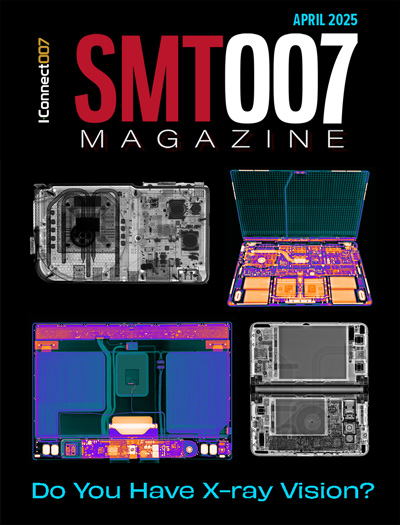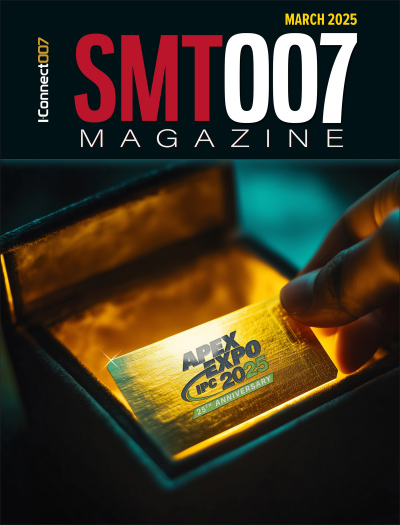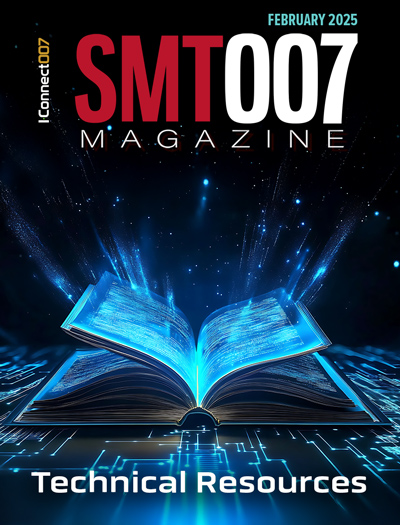-

- News
- Books
Featured Books
- smt007 Magazine
Latest Issues
Current Issue
Do You Have X-ray Vision?
Has X-ray’s time finally come in electronics manufacturing? Join us in this issue of SMT007 Magazine, where we answer this question and others to bring more efficiency to your bottom line.

IPC APEX EXPO 2025: A Preview
It’s that time again. If you’re going to Anaheim for IPC APEX EXPO 2025, we’ll see you there. In the meantime, consider this issue of SMT007 Magazine to be your golden ticket to planning the show.

Technical Resources
Key industry organizations–all with knowledge sharing as a part of their mission–share their technical repositories in this issue of SMT007 Magazine. Where can you find information critical to your work? Odds are, right here.
- Articles
- Columns
Search Console
- Links
- Media kit
||| MENU - smt007 Magazine
Dispensing Solder Paste at High Speed with Piezoelectric Drive Technology
December 31, 1969 |Estimated reading time: 10 minutes
By Dan Ashley and Steven J. Adamson, Asymtek
Traditional technologies for solder paste dispensing have limitations that can impact throughput and yield. A new technology for high-speed, small-dot solder paste dispensing has been developed, combining piezoelectric drive technology with a new gate valve design.
Solder paste dispensing is usually considered a slow process. Due to the speed advantages, screen printing is used to apply solder paste whenever possible. However, screen printing is not always an option. Leveraging the high speed of piezo drive technology opens the door to a broad range of solder paste dispensing applications. The ability to dispense dots under 300-µm diameter, even as small as 125 µm, enables BGA rework, small geometry deposits for miniaturized passive components, electrical connections in recessed cavities, and RF shield attach for handheld devices.
Traditional Paste Dispensing MethodsTwo methods currently dominate solder paste dispensing. The simplest is time/pressure based, where air pressure is toggled on for a preset duration and then off to complete the dot or line. The air pressure is developed within the syringe holding the paste, and the paste is forced through a needle tip. Paste formulation, pressure on time, needle diameter, and dispense gap are the most common variables that affect dot diameter. Although simple to use, time/pressure valves typically produce large variations in dot diameter and volume.
The second and more commonly used valve type is the auger valve. Auger valves use rotating threads in close proximity to a cylinder wall to force paste downward through the needle tip.1 These valves rely on fluid pressure to supply a continuous feed of paste into the auger chamber during dispense. Although more precise than time/pressure valves, auger valves usually are more complicated to operate, with a larger degree of variables controlling dispense volume.
 Figure 1. A slider valve.
Figure 1. A slider valve.
The most common problem with solder paste dispensing is clogging inside the dispense needle. Because the alloys typically used in paste formulations are soft metals, they are easily deformed, which increases the probability for matter plugging and clogging in the needle tip.
Piezoelectric-actuated Paste Dispensing Piezo dispensing produces very fine dots of fluids. Historically, it has been limited to inks with a viscosity of 20 cps or less, too low for thick solder paste. To overcome this, a valve was designed to use piezo technology with higher-viscosity fluids. It uses a sliding action to control the flow of solder paste, enabling high-speed, small-dot-diameter paste deposition.
 Figure 2. Sliding disks align for paste deposit.
Figure 2. Sliding disks align for paste deposit.
A syringe pressure slightly higher than that used with auger valves, about 50 to 65 psi, is applied to the solder paste feeding the valve. A slider valve blocks the solder paste from entering the dispense tip. When triggered, the slider is moved to align the feed hole from the paste syringe with an orifice in the base of the valve. Air pressure forces the paste into the dispensing tip and onto a solder pad (Figure 2). Off-the-shelf dispensing tips or needles can be used to vary the dot size. The upper disk is coupled to a piezoelectric drive system, so the valve opens and closes in less than 5 msec. Because the valve opens and closes so quickly, the pressure required to move the paste can be set relatively high. With high pressure behind the paste and a high-frequency valve, there is enough energy transferred into the paste to form a dot quickly without waiting for paste wetting onto the substrate. It also creates a precise mechanism to control the volume of solder paste dispensed. As there is a non-evasive flow path, there is less chance of deforming the soft solder spheres, minimizing clogging.
Piezo Slider ValvesTesting shows that piezo-actuated dispense technology is capable of 256-µm-diameter dots with ±8% variation at 3 sigma (Figure 3). However, piezo-actuated technology generally is capable of dot diameters as small as 121 µm (Figure 4). The ability to dispense solder paste dots under 300 µm in diameter opens the door for many BGA and quad flat pack no lead (QFN) rework applications.
 Figure 3. 256-µm dot repeatability.
Figure 3. 256-µm dot repeatability.
Comparison tests were performed to assess at what speed auger valves must run to obtain similar results to the piezo slider valve. Both valves were optimized to give similar quality dots at the fastest speed possible. The best speed that the auger valve was able to achieve was 11,250 dots per hour. The slider valve was running at a speed of 20,000 dots per hour.
 121-µm dot repeatability.
121-µm dot repeatability.
The piezo valve design is compatible with a range of paste types and alloys, such as 3-, 4, 5-, and 6-type pastes in lead-free, leaded, RMA, and no-clean varieties. Smaller-volume deposits are limited only by the inner diameter of the needle tip. Generally, the needle's inner diameter should be larger than seven solder ball diameters. With piezoelectric dispensing, lower grade, less-expensive pastes can be used and still produce small dots, as the valve is less susceptible to process or paste variations.
Applications BGA and QFN Rework. In rework, after the problematic component is removed, the PCB surface is prepared for mounting the replacement part. Solder paste is applied to each pad location. A common technique for adding new paste is using a micro-stencil for selective screen printing. This is a manual process, so there are variations in the results. Speed or angle changes during micro-stencil removal affect the volume of paste on pads. There also is variation in BGA ball geometry. These factors combined can result in recurring failures during electrical test or latent failures in the field.
Positioning the stencil to fit onto a populated PCB with components placed in close proximity is another problem. Frequently, the outer perimeter of the micro-stencil conflicts with previously placed components. It is possible to print the paste directly onto the BGA balls; however, this requires a specific jig for each BGA geometry and there are still paste transfer and operator handling issues. Finally, every BGA with a different geometry, I/O count, or pitch requires a unique, individual micro-stencil.
Deploying a dispensing technology capable of producing paste deposit geometries that fit onto the component land pad is desirable. If the paste is dispensed rather than screen printed, the variation in volume is minimized and the result will be a successful rework operation. Automating the rework process with a dispense platform removes operator-to-operator differences and eliminates the need for a large inventory of micro-stencils. An additional ability to program dispensing for each component type or geometry adds flexibility to the rework process.
Small Geometry Passives. There are several scenarios where screen printing has limitations. Circuit boards with a large variety of component sizes, including small geometry passives 0402, 0201, 01005 can be challenging. The stencil thickness must be specified for the range of apertures dictated by each component's size. Larger components require larger apertures and thicker stencils, while smaller components require smaller apertures and thinner stencils to ensure adequate paste transfer for each component size. When thicker stencils are used with smaller components, too much paste can be transferred onto the small pads. When thinner stencils are used with large components, there is the risk of depositing too little paste.
There is some concern that using piezo-actuated dispensing for small components will cause a bottleneck, holding up the assembly line. This problem can be avoided by dedicating a separate dispensing process to small geometry components while the screen printer is used on large geometry components. With modern piezo-actuated paste dispensing technology, dot dispense rates are getting higher. In most cases, there are many more large geometry components than small ones, so the amount of time that is required to dispense on the smaller component pads is minimal.
Electronics in Recessed Cavities. Many products require electrical connections in recessed cavities. If the topography of the bare PCB, substrate, or component varies, it's not possible to print solder paste, so dispensing is an obvious choice. With traditional paste dispensers, depositing small volumes of paste usually requires the use of footed needles. By adding a stand-off beside the needle tip and allowing the stand-off to touch down on the substrate surface, the dispense gap is controlled tightly. By controlling the dispense gap and increasing the amount of time the needle tip remains at each dispense location, traditional paste dispensers are capable of small-volume paste deposits. However, a foot or stand-off can interfere with previously dispensed paste or neighboring components and part geometries, and it's a slow process. Piezo dispensers apply pressure above the paste and then quickly actuate the sliding valve to impart energy into the paste for high-speed transfer of paste from the needle tip to the substrate surface. This reduces the dwell time at each dispense location and minimizes the need for tight gap control.
RF Shield Attach. Handheld devices often contain an RF shield to block radio frequency signals. The shield is soldered to the PCB surface and usually requires more solder than would be applied to a small resistor or capacitor chip. Piezo dispensing's ability to lay continuous lines of solder paste onto the PCB surface can be used to apply all the paste required for shield attachment or add paste to a printed line. Line widths as small as 250 µm are possible and necessary on densely populated boards, to avoid bridging with neighboring components. The variation in active components' quantity and sizes necessitates large variations in shield geometries. Programming new dispense patterns in a short time can add flexibility to the production line with RF shielding applications.
ConclusionSolder dispensing has a reputation as a slow operation. However, piezo slider valves are capable of increasing throughput significantly with reduced variation in dot quality when compared to the traditional auger valve. With dot capability below 0.3 mm, it can be used to put paste onto the smallest pads used with modern 01005s, or larger pads for large components. The valve can be used with a variety of lead-free pastes, and it produces good results even with lower-grade solder pastes. With the piezo slider valve, small solder paste dots can be produced at high speeds with quality and repeatable results.
REFERENCES: 1. Al Lewis, "Formulation Considerations for Automated Dispensing of Lead Free Solder Paste," IPC / JEDEC 5 International Conference on Lead Free Electronics and Assemblies, 2004.
Dan Ashley, product marketing specialist, and Steven J. Adamson, market manager, may be contacted at Asymtek, 2762 Loker Avenue West, Carlsbad, Calif. 92008.
Understanding Optimum Material Properties for DispensingDispensed materials are used for a variety of applications in electronic devices. Surface mount adhesives (SMAs), underfills, conformal coatings, potting materials, and many others often are deposited via an automated dispensing system onto a substrate. In all cases, the materials not only must be designed and engineered to provide the intended function (adhesion, increased reliability), but they also must deliver ease of use. In addition, dispensed materials must provide the correct properties, with respect to flow, once applied to the circuit board assembly. Flow and performance properties are achieved by balancing a number of the ingredients in the adhesive formulation, including filler particle type and sizes, resins, and rheology modifiers.
Erroneously, many engineers often try to summarize the "dispensability" of a given material by a single material parameter: viscosity. In reality, the true ability of the material to be dispensed goes far beyond this one property. Two of the more common dispensed materials used in electronics SMAs and underfills are thixotropic materials, defined as material whose viscosity drops with time when held at a constant shear rate. In short, this means that, once force is applied to the material, the viscosity drops. In dispensing, this force can be in the form of a piston pushing down (time/pressure dispenser), a screw pushing on the material (auger pump), or a ball piston pushing material though a nozzle. In all cases, the force acting on the material lowers the viscosity of that material, increasing its ability to flow. Once this force is no longer being applied and the material is on the substrate, the viscosity "recovers." In the case of an SMA, the result is a dot of material with a peak. In the case of an underfill material, capillary forces draw the material under a CSP or BGA with more force and more shear thinning and, once the material exits on the other side of the device, it self-fillets, forming a fillet around the edge of the area array device. During the development of these materials, dispensability and processability are key factors. With the advent of newer, non-contact dispensing systems there is certainly much more to dispensing a material than viscosity measured at a single shear rate. Newer dispense methods dictate that material separation and droplet formation upon nozzle ejection are evaluated, as these are properties that can be adjusted in the formulation stages of development. Dispensability of an adhesive or underfill is a complicated balance of raw material properties and should be determined and defined as part of the development process.
Brian Toleno, Ph.D., director of technical service, the electronics group of Henkel, may be contacted at 15350 Barranca Parkway, Irvine, Calif. 92608; brian.toleno@us.henkel.com.
Published in the July 2008 issue of SMT.


